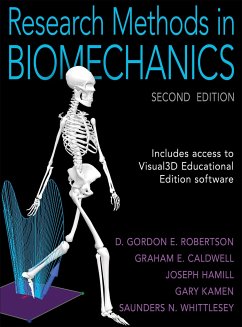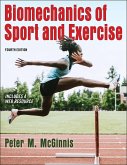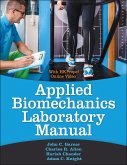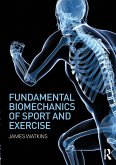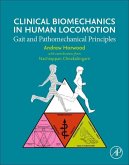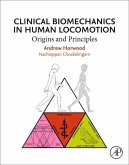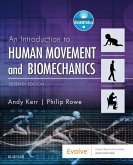- Gebundenes Buch
- Merkliste
- Auf die Merkliste
- Bewerten Bewerten
- Teilen
- Produkt teilen
- Produkterinnerung
- Produkterinnerung
In the highly technical field of biomechanics, research methods are frequently upgraded as the speed and sophistication of software and hardware technologies increase. This second edition features more than 100 new pieces of art and illustrations and chapters introducing various techniques and areas of research.
Andere Kunden interessierten sich auch für
![Biomechanics of Sport and Exercise Biomechanics of Sport and Exercise]() Peter M. McGinnisBiomechanics of Sport and Exercise136,99 €
Peter M. McGinnisBiomechanics of Sport and Exercise136,99 €![Applied Biomechanics Lab Manual Applied Biomechanics Lab Manual]() John C. GarnerApplied Biomechanics Lab Manual87,99 €
John C. GarnerApplied Biomechanics Lab Manual87,99 €![Fundamental Biomechanics of Sport and Exercise Fundamental Biomechanics of Sport and Exercise]() James WatkinsFundamental Biomechanics of Sport and Exercise58,99 €
James WatkinsFundamental Biomechanics of Sport and Exercise58,99 €![Reduced Order Models for the Biomechanics of Living Organs Reduced Order Models for the Biomechanics of Living Organs]() Reduced Order Models for the Biomechanics of Living Organs192,99 €
Reduced Order Models for the Biomechanics of Living Organs192,99 €![Clinical Biomechanics in Human Locomotion Clinical Biomechanics in Human Locomotion]() Andrew Horwood (Centre for Biomechanics Visiting Fellow and RehabiClinical Biomechanics in Human Locomotion192,99 €
Andrew Horwood (Centre for Biomechanics Visiting Fellow and RehabiClinical Biomechanics in Human Locomotion192,99 €![Clinical Biomechanics in Human Locomotion Clinical Biomechanics in Human Locomotion]() Andrew Horwood (Centre for Biomechanics Visiting Fellow and RehabiClinical Biomechanics in Human Locomotion143,99 €
Andrew Horwood (Centre for Biomechanics Visiting Fellow and RehabiClinical Biomechanics in Human Locomotion143,99 €![Human Movement & Biomechanics Human Movement & Biomechanics]() Human Movement & Biomechanics68,99 €
Human Movement & Biomechanics68,99 €-
-
-
In the highly technical field of biomechanics, research methods are frequently upgraded as the speed and sophistication of software and hardware technologies increase. This second edition features more than 100 new pieces of art and illustrations and chapters introducing various techniques and areas of research.
Hinweis: Dieser Artikel kann nur an eine deutsche Lieferadresse ausgeliefert werden.
Hinweis: Dieser Artikel kann nur an eine deutsche Lieferadresse ausgeliefert werden.
Produktdetails
- Produktdetails
- Verlag: Human Kinetics Publishers
- 2 ed
- Seitenzahl: 440
- Erscheinungstermin: 1. November 2013
- Englisch
- Abmessung: 288mm x 225mm x 33mm
- Gewicht: 1464g
- ISBN-13: 9780736093408
- ISBN-10: 0736093400
- Artikelnr.: 39122207
- Verlag: Human Kinetics Publishers
- 2 ed
- Seitenzahl: 440
- Erscheinungstermin: 1. November 2013
- Englisch
- Abmessung: 288mm x 225mm x 33mm
- Gewicht: 1464g
- ISBN-13: 9780736093408
- ISBN-10: 0736093400
- Artikelnr.: 39122207
D. Gordon E. Robertson, PhD, an emeritus professor and a fellow of the Canadian Society for Biomechanics, wrote Introduction to Biomechanics for Human Motion Analysis. He taught undergraduate- and graduate-level biomechanics at the University of Ottawa and previously at the University of British Columbia, Canada. He conducts research on human locomotion and athletic activities and authors the analogue data analysis software BioProc3. Graham E. Caldwell, PhD, an associate professor and a fellow of the Canadian Society for Biomechanics, teaches undergraduate- and graduate-level biomechanics at the University of Massachusetts at Amherst and previously held a similar faculty position at the University of Maryland. He won the Canadian Society for Biomechanics New Investigator Award and in 1998 won the Outstanding Teacher Award for the School of Public Health and Health Sciences at the University of Massachusetts at Amherst. He served as an associate editor for Medicine and Science in Sports and Exercise. Joseph Hamill, PhD, is a professor and fellow of the Research Consortium, International Society of Biomechanics in Sports, Canadian Society for Biomechanics, American College of Sports Medicine, and National Academy of Kinesiology. He coauthored the popular undergraduate textbook Biomechanical Basis of Human Movement. He teaches undergraduate- and graduate-level biomechanics and is director of the Biomechanics Laboratory at the University of Massachusetts at Amherst. He serves on the editorial boards of several prestigious professional journals. He is adjunct professor at the University of Edinburgh in Scotland and the University of Limerick in Ireland and a distinguished research professor at Republic Polytechnic in Singapore. Gary Kamen, PhD, is a professor and fellow of the American Alliance for Health, Physical Education, Recreation and Dance; American College of Sports Medicine; and National Academy of Kinesiology. He authored an undergraduate textbook on kinesiology, Foundations of Exercise Science, as well as a primer on electromyography, Essentials of Electromyography. He was president of the Research Consortium of AAPHERD and teaches undergraduate and graduate courses in exercise neuroscience and motor control in the department of kinesiology at the University of Massachusetts at Amherst. Saunders (Sandy) N. Whittlesey, PhD, a graduate of the University of Massachusetts at Amherst, is a self-employed technology consultant specializing in athletic training, sporting goods, and clinical applications. Additional Contributors Norma Coffey, PhD, a postdoctoral researcher in statistics at the National University of Ireland at Galway, has expertise is functional data analysis and worked extensively with the Biomechanics Research Unit at the University of Limerick. Her current area of research involves applying functional data analysis techniques to time-course gene expression data. Timothy R. Derrick, PhD, a professor in the department of kinesiology at Iowa State University, has an extensive background in signal processing and conducts research on impacts to the human body particularly from the ground during running activities. Kevin Deluzio, PhD, is a professor in the department of mechanical and materials engineering at Queen's University in Kingston, Canada, and held a similar position at Dalhousie University. He studies human locomotion to investigate the biomechanical factors of musculoskeletal diseases such as knee osteoarthritis. He is also interested in the design and evaluation of noninvasive therapies as well as surgical treatments such as total-knee replacement. Andrew (Drew) J. Harrison, PhD, is a senior lecturer in biomechanics in the department of physical education and sport sciences at the University of Limerick in Ireland and a fellow of the International Society for Biomechanics in Sport. He is the director of the Biomechanics Research Unit at the University of Limerick. His research focuses on biomechanics of sport performance and sport injuries. Thomas M. Kepple, PhD, is an instructor in the department of health, nutrition, and exercise sciences at the University of Delaware. He worked for many years as a biomechanist at the National Institutes of Health on motion capture technology and gait laboratory instrumentation. Ross H. Miller, PhD, an assistant professor in the department of kinesiology at the University of Maryland, has published papers on static optimization and forward dynamics as well as methods on nonlinear techniques of data analysis. Scott Selbie, PhD, is an adjunct professor at Queen's University, Canada, and at the University of Massachusetts at Amherst. He is a graduate of Simon Fraser University, Canada. He is the director of research at C-Motion, developers of the Visual3D software, and president of HAS-Motion in Canada. Brian R. Umberger, PhD, is an associate professor teaching biomechanics at the undergraduate and graduate levels in the department of kinesiology at the University of Massachusetts at Amherst. In 2010, he received the Outstanding Teacher Award for the School of Public Health and Health Sciences at the University of Massachusetts at Amherst. In his research, he uses a combination of experimental, modeling, and simulation approaches to study the biomechanics and energetics of human locomotion. Richard E.A. van Emmerik, PhD, is a professor in the kinesiology department at the University of Massachusetts at Amherst, where he teaches motor control at the undergraduate and graduate levels. In his research, he applies principles from complex and nonlinear dynamical systems to the study of posture and locomotion.
Part I. Kinematics
Chapter 1. Planar Kinematics
D. Gordon E. Robertson and Graham E. Caldwell
Description of Position
Degrees of Freedom
Kinematic Data Collection
Linear Kinematics
Angular Kinematics
Summary
Suggested Readings
Chapter 2. Three-Dimensional Kinematics
Joseph Hamill, W. Scott Selbie, and Thomas M. Kepple
Collection of Three-Dimensional Data
Coordinate Systems and Assumption of Rigid Segments
Transformations between Coordinate Systems
Defining the Segment LCS for the Lower Extremity
Pose Estimation: Tracking the Segment LCS
Joint Angles
Joint Angular Velocity and Angular Acceleration of Cardan Joint Angles
Summary
Suggested Readings
Part II. Kinetics
Chapter 3. Body Segment Parameters
D. Gordon E. Robertson
Methods for Measuring and Estimating Body Segment Parameters
Two-Dimensional (Planar) Computational Methods
Three-Dimensional (Spatial) Computational Methods
Summary
Suggested Readings
Chapter 4. Forces and Their Measurement
Graham E. Caldwell, D. Gordon E. Robertson, and Saunders N. Whittlesey
Force
Newton's Laws
Free-Body Diagrams
Types of Forces
Moment of Force, or Torque
Linear Impulse and Momentum
Angular Impulse and Momentum
Measurement of Force
Summary
Suggested Readings
Chapter 5. Two-Dimensional Inverse Dynamics
Saunders N. Whittlesey and D. Gordon E. Robertson
Planar Motion Analysis
Numerical Formulation
Human Joint Kinetics
Applications
Summary
Suggested Readings
Chapter 6. Energy, Work, and Power
D. Gordon E. Robertson
Energy, Work, and the Laws of Thermodynamics
Conservation of Mechanical Energy
Ergometry: Direct Methods
Ergometry: Indirect Methods
Mechanical Efficiency
Summary
Suggested Readings
Chapter 7. Three-Dimensional Kinetics
W. Scott Selbie, Joseph Hamill, and Thomas Kepple
Segments and Link Models
3-D Inverse Dynamics Analysis
Presentation of the Net Moment Data
Joint Power
Interpretation of Net Joint Moments
Sources of Error in Three-Dimensional Calculations
Summary
Suggested Readings
Part III. Muscles, Models, and Movement
Chapter 8. Electromyographic Kinesiology
Gary Kamen
Physiological Origin of the Electromyographic Signal
Recording and Acquiring the Electromyographic Signal
Analyzing and Interpreting the Electromyographic Signal
Applications for Electromyographic Techniques
Summary
Suggested Readings
Chapter 9. Muscle Modeling
Graham E. Caldwell
The Hill Muscle Model
Muscle-Specific Hill Models
Beyond the Hill Model
Summary
Suggested Readings
Chapter 10. Computer Simulation of Human Movement
Saunders N. Whittlesey and Joseph Hamill
Overview: Modeling As a Process
Why Simulate Human Movement?
General Procedure for Simulations
Control Theory
Limitations of Computer Models
Summary
Suggested Readings
Chapter 11. Musculoskeletal Modeling
Brian R. Umberger and Graham E. Caldwell
Musculoskeletal Models
Control Models
Analysis Techniques
Summary
Suggested Readings
Part IV. Further Analytical Procedures
Chapter 12. Signal Processing
Timothy R. Derrick and D. Gordon E. Robertson
Characteristics of a Signal
Fourier Transform
Time-Dependent Fourier Transform
Sampling Theorem
Ensuring Circular Continuity
Smoothing Data
Summary
Suggested Readings
Chapter 13. Dynamical Systems Analysis of Coordination
Richard E.A. van Emmerik, Ross H. Miller, and Joseph Hamill
Movement Coordination
Foundations for Coordination Analysis
Quantifying Coordination: Relative Phase Methods
Quantifying Coordination: Vector Coding
Overview of Coordination Analysis Techniques
Summary
Suggested Readings
Chapter 14. Analysis of Biomechanical Waveform Data
Kevin J. Deluzio, Andrew J. Harrison, Norma Coffey, and Graham E. Caldwell
Biomechanical Waveform Data
Principal Component Analysis
Functional Data Analysis
Comparison of PCA and FDA
Summary
Suggested Readings
Chapter 1. Planar Kinematics
D. Gordon E. Robertson and Graham E. Caldwell
Description of Position
Degrees of Freedom
Kinematic Data Collection
Linear Kinematics
Angular Kinematics
Summary
Suggested Readings
Chapter 2. Three-Dimensional Kinematics
Joseph Hamill, W. Scott Selbie, and Thomas M. Kepple
Collection of Three-Dimensional Data
Coordinate Systems and Assumption of Rigid Segments
Transformations between Coordinate Systems
Defining the Segment LCS for the Lower Extremity
Pose Estimation: Tracking the Segment LCS
Joint Angles
Joint Angular Velocity and Angular Acceleration of Cardan Joint Angles
Summary
Suggested Readings
Part II. Kinetics
Chapter 3. Body Segment Parameters
D. Gordon E. Robertson
Methods for Measuring and Estimating Body Segment Parameters
Two-Dimensional (Planar) Computational Methods
Three-Dimensional (Spatial) Computational Methods
Summary
Suggested Readings
Chapter 4. Forces and Their Measurement
Graham E. Caldwell, D. Gordon E. Robertson, and Saunders N. Whittlesey
Force
Newton's Laws
Free-Body Diagrams
Types of Forces
Moment of Force, or Torque
Linear Impulse and Momentum
Angular Impulse and Momentum
Measurement of Force
Summary
Suggested Readings
Chapter 5. Two-Dimensional Inverse Dynamics
Saunders N. Whittlesey and D. Gordon E. Robertson
Planar Motion Analysis
Numerical Formulation
Human Joint Kinetics
Applications
Summary
Suggested Readings
Chapter 6. Energy, Work, and Power
D. Gordon E. Robertson
Energy, Work, and the Laws of Thermodynamics
Conservation of Mechanical Energy
Ergometry: Direct Methods
Ergometry: Indirect Methods
Mechanical Efficiency
Summary
Suggested Readings
Chapter 7. Three-Dimensional Kinetics
W. Scott Selbie, Joseph Hamill, and Thomas Kepple
Segments and Link Models
3-D Inverse Dynamics Analysis
Presentation of the Net Moment Data
Joint Power
Interpretation of Net Joint Moments
Sources of Error in Three-Dimensional Calculations
Summary
Suggested Readings
Part III. Muscles, Models, and Movement
Chapter 8. Electromyographic Kinesiology
Gary Kamen
Physiological Origin of the Electromyographic Signal
Recording and Acquiring the Electromyographic Signal
Analyzing and Interpreting the Electromyographic Signal
Applications for Electromyographic Techniques
Summary
Suggested Readings
Chapter 9. Muscle Modeling
Graham E. Caldwell
The Hill Muscle Model
Muscle-Specific Hill Models
Beyond the Hill Model
Summary
Suggested Readings
Chapter 10. Computer Simulation of Human Movement
Saunders N. Whittlesey and Joseph Hamill
Overview: Modeling As a Process
Why Simulate Human Movement?
General Procedure for Simulations
Control Theory
Limitations of Computer Models
Summary
Suggested Readings
Chapter 11. Musculoskeletal Modeling
Brian R. Umberger and Graham E. Caldwell
Musculoskeletal Models
Control Models
Analysis Techniques
Summary
Suggested Readings
Part IV. Further Analytical Procedures
Chapter 12. Signal Processing
Timothy R. Derrick and D. Gordon E. Robertson
Characteristics of a Signal
Fourier Transform
Time-Dependent Fourier Transform
Sampling Theorem
Ensuring Circular Continuity
Smoothing Data
Summary
Suggested Readings
Chapter 13. Dynamical Systems Analysis of Coordination
Richard E.A. van Emmerik, Ross H. Miller, and Joseph Hamill
Movement Coordination
Foundations for Coordination Analysis
Quantifying Coordination: Relative Phase Methods
Quantifying Coordination: Vector Coding
Overview of Coordination Analysis Techniques
Summary
Suggested Readings
Chapter 14. Analysis of Biomechanical Waveform Data
Kevin J. Deluzio, Andrew J. Harrison, Norma Coffey, and Graham E. Caldwell
Biomechanical Waveform Data
Principal Component Analysis
Functional Data Analysis
Comparison of PCA and FDA
Summary
Suggested Readings
Part I. Kinematics
Chapter 1. Planar Kinematics
D. Gordon E. Robertson and Graham E. Caldwell
Description of Position
Degrees of Freedom
Kinematic Data Collection
Linear Kinematics
Angular Kinematics
Summary
Suggested Readings
Chapter 2. Three-Dimensional Kinematics
Joseph Hamill, W. Scott Selbie, and Thomas M. Kepple
Collection of Three-Dimensional Data
Coordinate Systems and Assumption of Rigid Segments
Transformations between Coordinate Systems
Defining the Segment LCS for the Lower Extremity
Pose Estimation: Tracking the Segment LCS
Joint Angles
Joint Angular Velocity and Angular Acceleration of Cardan Joint Angles
Summary
Suggested Readings
Part II. Kinetics
Chapter 3. Body Segment Parameters
D. Gordon E. Robertson
Methods for Measuring and Estimating Body Segment Parameters
Two-Dimensional (Planar) Computational Methods
Three-Dimensional (Spatial) Computational Methods
Summary
Suggested Readings
Chapter 4. Forces and Their Measurement
Graham E. Caldwell, D. Gordon E. Robertson, and Saunders N. Whittlesey
Force
Newton's Laws
Free-Body Diagrams
Types of Forces
Moment of Force, or Torque
Linear Impulse and Momentum
Angular Impulse and Momentum
Measurement of Force
Summary
Suggested Readings
Chapter 5. Two-Dimensional Inverse Dynamics
Saunders N. Whittlesey and D. Gordon E. Robertson
Planar Motion Analysis
Numerical Formulation
Human Joint Kinetics
Applications
Summary
Suggested Readings
Chapter 6. Energy, Work, and Power
D. Gordon E. Robertson
Energy, Work, and the Laws of Thermodynamics
Conservation of Mechanical Energy
Ergometry: Direct Methods
Ergometry: Indirect Methods
Mechanical Efficiency
Summary
Suggested Readings
Chapter 7. Three-Dimensional Kinetics
W. Scott Selbie, Joseph Hamill, and Thomas Kepple
Segments and Link Models
3-D Inverse Dynamics Analysis
Presentation of the Net Moment Data
Joint Power
Interpretation of Net Joint Moments
Sources of Error in Three-Dimensional Calculations
Summary
Suggested Readings
Part III. Muscles, Models, and Movement
Chapter 8. Electromyographic Kinesiology
Gary Kamen
Physiological Origin of the Electromyographic Signal
Recording and Acquiring the Electromyographic Signal
Analyzing and Interpreting the Electromyographic Signal
Applications for Electromyographic Techniques
Summary
Suggested Readings
Chapter 9. Muscle Modeling
Graham E. Caldwell
The Hill Muscle Model
Muscle-Specific Hill Models
Beyond the Hill Model
Summary
Suggested Readings
Chapter 10. Computer Simulation of Human Movement
Saunders N. Whittlesey and Joseph Hamill
Overview: Modeling As a Process
Why Simulate Human Movement?
General Procedure for Simulations
Control Theory
Limitations of Computer Models
Summary
Suggested Readings
Chapter 11. Musculoskeletal Modeling
Brian R. Umberger and Graham E. Caldwell
Musculoskeletal Models
Control Models
Analysis Techniques
Summary
Suggested Readings
Part IV. Further Analytical Procedures
Chapter 12. Signal Processing
Timothy R. Derrick and D. Gordon E. Robertson
Characteristics of a Signal
Fourier Transform
Time-Dependent Fourier Transform
Sampling Theorem
Ensuring Circular Continuity
Smoothing Data
Summary
Suggested Readings
Chapter 13. Dynamical Systems Analysis of Coordination
Richard E.A. van Emmerik, Ross H. Miller, and Joseph Hamill
Movement Coordination
Foundations for Coordination Analysis
Quantifying Coordination: Relative Phase Methods
Quantifying Coordination: Vector Coding
Overview of Coordination Analysis Techniques
Summary
Suggested Readings
Chapter 14. Analysis of Biomechanical Waveform Data
Kevin J. Deluzio, Andrew J. Harrison, Norma Coffey, and Graham E. Caldwell
Biomechanical Waveform Data
Principal Component Analysis
Functional Data Analysis
Comparison of PCA and FDA
Summary
Suggested Readings
Chapter 1. Planar Kinematics
D. Gordon E. Robertson and Graham E. Caldwell
Description of Position
Degrees of Freedom
Kinematic Data Collection
Linear Kinematics
Angular Kinematics
Summary
Suggested Readings
Chapter 2. Three-Dimensional Kinematics
Joseph Hamill, W. Scott Selbie, and Thomas M. Kepple
Collection of Three-Dimensional Data
Coordinate Systems and Assumption of Rigid Segments
Transformations between Coordinate Systems
Defining the Segment LCS for the Lower Extremity
Pose Estimation: Tracking the Segment LCS
Joint Angles
Joint Angular Velocity and Angular Acceleration of Cardan Joint Angles
Summary
Suggested Readings
Part II. Kinetics
Chapter 3. Body Segment Parameters
D. Gordon E. Robertson
Methods for Measuring and Estimating Body Segment Parameters
Two-Dimensional (Planar) Computational Methods
Three-Dimensional (Spatial) Computational Methods
Summary
Suggested Readings
Chapter 4. Forces and Their Measurement
Graham E. Caldwell, D. Gordon E. Robertson, and Saunders N. Whittlesey
Force
Newton's Laws
Free-Body Diagrams
Types of Forces
Moment of Force, or Torque
Linear Impulse and Momentum
Angular Impulse and Momentum
Measurement of Force
Summary
Suggested Readings
Chapter 5. Two-Dimensional Inverse Dynamics
Saunders N. Whittlesey and D. Gordon E. Robertson
Planar Motion Analysis
Numerical Formulation
Human Joint Kinetics
Applications
Summary
Suggested Readings
Chapter 6. Energy, Work, and Power
D. Gordon E. Robertson
Energy, Work, and the Laws of Thermodynamics
Conservation of Mechanical Energy
Ergometry: Direct Methods
Ergometry: Indirect Methods
Mechanical Efficiency
Summary
Suggested Readings
Chapter 7. Three-Dimensional Kinetics
W. Scott Selbie, Joseph Hamill, and Thomas Kepple
Segments and Link Models
3-D Inverse Dynamics Analysis
Presentation of the Net Moment Data
Joint Power
Interpretation of Net Joint Moments
Sources of Error in Three-Dimensional Calculations
Summary
Suggested Readings
Part III. Muscles, Models, and Movement
Chapter 8. Electromyographic Kinesiology
Gary Kamen
Physiological Origin of the Electromyographic Signal
Recording and Acquiring the Electromyographic Signal
Analyzing and Interpreting the Electromyographic Signal
Applications for Electromyographic Techniques
Summary
Suggested Readings
Chapter 9. Muscle Modeling
Graham E. Caldwell
The Hill Muscle Model
Muscle-Specific Hill Models
Beyond the Hill Model
Summary
Suggested Readings
Chapter 10. Computer Simulation of Human Movement
Saunders N. Whittlesey and Joseph Hamill
Overview: Modeling As a Process
Why Simulate Human Movement?
General Procedure for Simulations
Control Theory
Limitations of Computer Models
Summary
Suggested Readings
Chapter 11. Musculoskeletal Modeling
Brian R. Umberger and Graham E. Caldwell
Musculoskeletal Models
Control Models
Analysis Techniques
Summary
Suggested Readings
Part IV. Further Analytical Procedures
Chapter 12. Signal Processing
Timothy R. Derrick and D. Gordon E. Robertson
Characteristics of a Signal
Fourier Transform
Time-Dependent Fourier Transform
Sampling Theorem
Ensuring Circular Continuity
Smoothing Data
Summary
Suggested Readings
Chapter 13. Dynamical Systems Analysis of Coordination
Richard E.A. van Emmerik, Ross H. Miller, and Joseph Hamill
Movement Coordination
Foundations for Coordination Analysis
Quantifying Coordination: Relative Phase Methods
Quantifying Coordination: Vector Coding
Overview of Coordination Analysis Techniques
Summary
Suggested Readings
Chapter 14. Analysis of Biomechanical Waveform Data
Kevin J. Deluzio, Andrew J. Harrison, Norma Coffey, and Graham E. Caldwell
Biomechanical Waveform Data
Principal Component Analysis
Functional Data Analysis
Comparison of PCA and FDA
Summary
Suggested Readings
